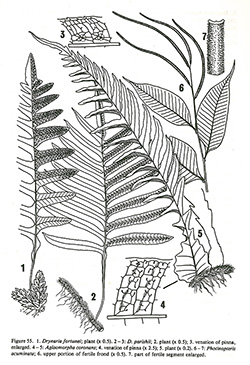e-Flora of Thailand
Volume 3 > Part 4 > Year 1989 > Page 551–552 > Polypodiaceae > Aglaomorpha
Aglaomorpha coronans (Wall. ex Mett.) Copel.wfo-0001125793
Univ. Calif. Publ. Bot. 16: 117. 1929; Tardieu & C.Chr. In Fl. Indo-Chine 7(2): 488. f. 57, 3–4. 1941; Holttum, Dansk Bot. Ark. 20: 21. 1961; Tagawa, J. Jap. Bot. 38: 328. 1963; Tagawa & K.Iwats., S.E. Asian Stud. 5: 57. 1967.— Polypodium coronans Wall. ex Mett., Abh. Senck. Naturf. Ges. 2: 121. t. 3. f. 40–41. 1857; Hosseus, Beih. Bot. Centralbl. 28(2): 366. 1911.— Pseudodrynaria coronans (Wall. ex Mett.) Ching, Sunyatsenia 5: 262. 1940; Holttum, Dansk Bot. Ark. 23: 231. 1965. Fig. 55. 4–5.
Accepted Name : Drynaria coronans (Wall. ex Mett.) J.Sm.
J. Bot. (Hooker) 4: 61. 1841; Bedd., Handb. Ferns Brit. India: 338. 1883.
Synonyms & Citations :
Description : A large epiphyte. Rhizome creeping, thick, usually more than 1.5 cm diam., densely scaly throughout; scales brown, linear, 10–15 by more than 0.5 mm, sharply toothed at margin. Fronds sessile, usually more than 1 m long, about 60 cm wide, lobed almost to rachix; lobes continuing with wings less than 1 cm broad; the base of fronds broadly rounded to cordate, up to 15 cm broad, subentire or shallowly lobed, brown, like the nest-leaves of Drynaria; lobes of the upper part of fronds ascending, usually more than a dozen pairs, linear-subtriangular, attenuately acuminate at apex, entire at margin, up to 40 by about 5 cm, every lobe falling at the abscission along rachis; veins raised on the both surfaces, venation drynarioid, or with complicately reticulate, main areoles quadrangular, smaller areoles with free included veinlets; coriaceous, green, glabrous. Sori one, or very rarely two, row(s) between main veins, more or less elongate, or sometimes uniting longitudinally, but rarely continuous beyond cross veins.
Thailand : NORTHERN: Chiang Rai (Doi Tung), Chiang Mai (Doi Suthep, Huai Tong, Doi Inthanon), Lampang (Mae Tia), Phrae (Mae Sai), Tak (Huai Krasa, Doi Hua Mot, Doi Musoe), Phitsanulok (Thung Salaeng Luang); EASTERN: Chaiyaphum (Thung Kamang, Nam Phrom); NORTH-EASTERN: Loei (Phu Luang, Phu Kradueng), Prachin Buri (Khao Yai); SOUTH-EASTERN: Chanthaburi (Khao Soi Dao); SOUTH-WESTERN: Kanchanaburi (Song Tho); PENINSULAR: Surat Thani (Ban Don), Nakhon Si Thammarat (Khao Luang), Trang (Khao Chong), Phangnga (Khao Phota Luang Kaeo).
Distribution : Himalayas to S China, Indochina, Taiwan and northwards to the Ryukyus, Khao Chong is the southernmost record of this species.
Ecology : On rather dry or mossy rocks or on tree-trunks in open places or in dense forests, not so rare at medium altitudes throughout Thailand.
Vernacular : Bai kut om (ใบกูดอ้อม)(Northern).
E-version notes : For more details see Ferns of Thailand, Laos and Cambodia.

